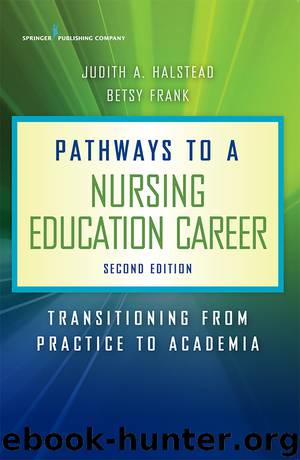Pathways to a Nursing Education Career, Second Edition by Halstead Judith A. Frank Betsy

Author:Halstead, Judith A.,Frank, Betsy
Language: eng
Format: epub
Publisher: Springer Publishing Company, Inc.
Published: 2017-07-24T00:00:00+00:00
What suggestions do you have for Lorraine that will help her engage her students? How would you approach this first day of class with these students?
A first step in establishing your student relationships is to decide how you wish to be addressed by your students and to communicate this to them the first time you meet with them. Most of the time this is a matter of personal preference, but if in doubt, do check with the protocol that is in use in your particular school. If you wish to be called Dr., Ms., Mr. or Mrs., or professor, be sure to tell your students—it is your prerogative to state your preference and to expect your students to respect it. Likewise, if you prefer to be addressed by your first name, state that as well. The authors of this book have always invited their students to either address them as Dr. or by first name—the students can choose whichever format they find most comfortable. You will find some students will always be more comfortable using the formal salutation. Of course, you should always ask your students’ preference with how they wish to be addressed as well when you are speaking with them.
Another initial step is to provide your students with contact information if they should need to speak with you outside of class or clinical times and under what circumstances you would expect them to contact you. Such contact information should contain your office number, office hours, office phone number, work email address, and, if you prefer, your home or cell phone number. Providing your home or cell phone number is a matter of personal preference; if you choose to do so, you may wish to establish time frame boundaries around which you will accept calls from students after work hours. You will also want to give your students some guidelines by which they can expect to hear back from you; for example, you may decide to tell students to allow you 24 to 48 hours to respond to all phone or email messages.
An appropriate and effective student–faculty relationship is one in which personal boundaries are established and mutual respect is demonstrated by all parties. Although some personal sharing is acceptable and even to be expected when you interact with students over a prolonged period of time, it is important to keep in mind that the nature of the student–faculty relationship is one that exists for the purposes of providing a learning environment that will enable your students to achieve their academic goals. The classroom or clinical setting is not the place to share detailed information about your own personal life.
Students, however, may share details with you about personal life situations that are affecting their ability to be successful academically. These situations may include personal illness; difficult family situations affecting spouses, parents, or children; marital issues; financial concerns; mental health or substance abuse concerns; or even domestic violence situations in which they may be involved, to give just a few examples.
Download
This site does not store any files on its server. We only index and link to content provided by other sites. Please contact the content providers to delete copyright contents if any and email us, we'll remove relevant links or contents immediately.
1610396766 (N) by Jo Ann Jenkins(1301)
Elizabeth Is Missing by Emma Healey(1235)
McGraw-Hill Nurses Drug Handbook by Patricia Schull(1190)
Economics and Financial Management for Nurses and Nurse Leaders, Third Edition by Susan J. Penner RN MN MPA DrPH CNL(1178)
Cherry Ames Boxed Set, Books 1 - 4 by Helen Wells(1155)
The Language of Kindness by Christie Watson(1120)
NCLEX-RN Prep Plus 2019 by Kaplan Nursing(1103)
Cherry Ames, Student Nurse by Helen Wells(1102)
Spiritual Midwifery by Ina May Gaskin(1083)
Whoever Tells the Best Story Wins: How to Use Your Own Stories to Communicate with Power and Impact by Annette Simmons(1060)
Cherry Ames Boxed Set, Books 5 - 8 by Helen Wells(1055)
Home. by Sarah Graham(1053)
Cracking the Nursing Interview by Jim Keogh(1027)
1476763445 by Liz Fenton(1007)
Dementia by June Andrews(931)
Getting Started with Arduino by Massimo Banzi(926)
Cherry Ames, Army Nurse by Helen Wells(901)
Shadows of the Workhouse: The Drama of Life in Postwar London by Jennifer Worth(892)
Children's Medicines by Edward A. Bell(890)
